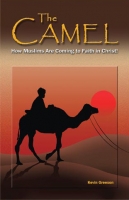Kevin Greeson: The Camel
 Kevin Greeson, The Camel: How Muslims Are Coming To Faith In Christ (Arkadelphia, AR: WIGTake Resources LLC, 2007), 210 pages, ISBN 9780974756295.
Kevin Greeson, The Camel: How Muslims Are Coming To Faith In Christ (Arkadelphia, AR: WIGTake Resources LLC, 2007), 210 pages, ISBN 9780974756295.
The Camel is a book of both testimony and teaching. The author shows us that God is at work among Muslims, he also shows us some things that we can do that will help us reach for them for Christ. If you think that reaching Muslims is “mission impossible” you will be surprised when you read this book. Kevin Greeson is a church planter who works for the International Mission Board of the Southern Baptist Convention. He serves as a missionary church planter in South Asia in an area that has a large Muslim population. In this book he shares how at one point in his ministry he was seeing very few results as he ministered to Muslims. During this same time he heard reports of large numbers of Muslims coming to Christ in other places. He investigated these reports and found them to be true. Muslim-background believers were leading many of their family and friends to the Lord. Greeson shares what he learned from these Muslim-background believers. He began to apply what he learned and found that their approach worked. In this book he shares the “secret of their success.” Their success was very significant; it resulted not just in individual conversions but in church planting movements. Most Christians in the West probably do not know how to begin a conversation with a Muslim about Christ, this book is a great help in this regard.
Greeson found a number of interesting things about the Muslim-background believers that were planting churches. He found that they used a different vocabulary, they did not try to use “foreign” religious language, they spoke from their Islamic heritage as long as it did not conflict with the Bible (page 34). For example, they called their pastor “imam,” this is a term used for Muslim religious leaders but it simply means “the one in front” (page 34). They also did not identify themselves as Christians; they referred to themselves as “Isahi Muslims.” This means that they are those who submit themselves to God by following Jesus. In short, what Greeson found was that the Muslim-background believers contextualized the gospel. They also used the Qur’an to witness. They did not dilute the gospel message but they presented it in a more appealing way to those from an Islamic background.
The “camel” is actually an acronym: c-a-m-e-l. It is a way to remember some of the key points found in Surah al-Imran, which is chapter three in the Qur’an. The “c” reminds us that Mary was chosen to be the mother of Jesus (Isa), “a” stands for the fact that angels made this known to her, “m” tells us that Jesus would do miracles and “el” tells us that Jesus knew the way to eternal life (pages 41-42). Muslim-background believers use this information to build bridges with their Muslims friends to lead them from the Qur’an to the New Testament. In addition to the “c-a-m-e-l” approach the book offers some other valuable information as well. It offers a more advanced evangelistic tool called “The Korbani Plan of Salvation” (pages 113-120) and it tells you how to answer a Muslim who says that you can not trust the Bible because it is corrupted (pages 139-140). There are also answers to some of the more common objections that Muslims may raise (pages 140-146).
Category: Ministry, Summer 2010


